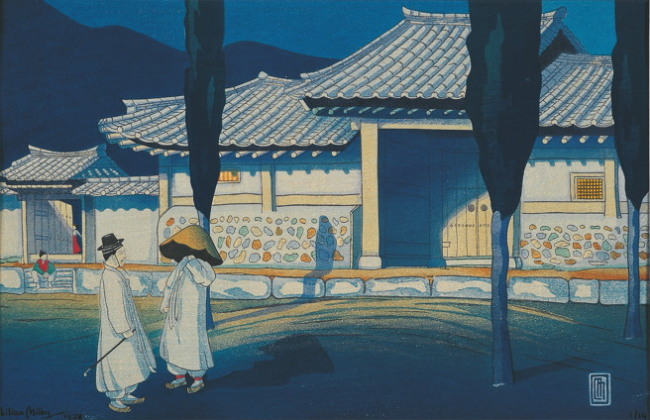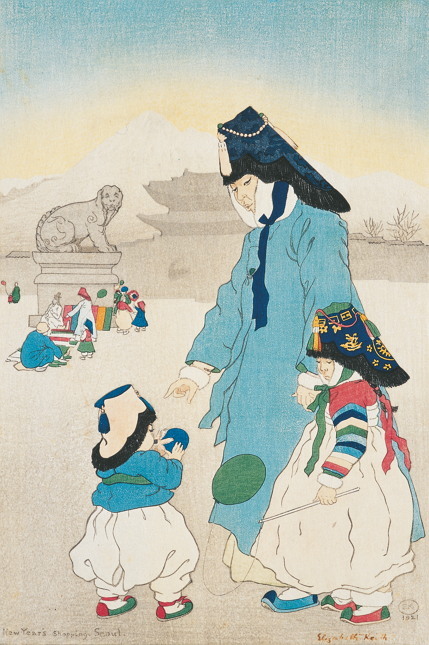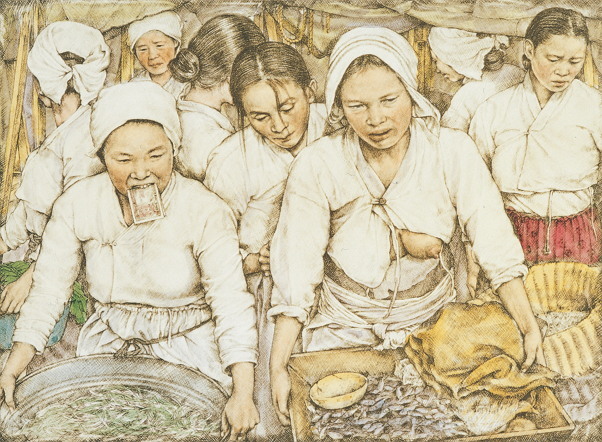Foreign views of Korea in early 1900s
Woodprints by foreign artists portray ordinary lives of Koreans under Japanese colonial rule
By Lee Woo-youngPublished : Feb. 5, 2015 - 20:00
A woman carrying a baby on her back and balancing a huge bucket on her head must have left a strong impression on American artist Lilian May Miller, who was born in Tokyo and briefly lived in Seoul after her father was appointed consul in 1918. She made a woodprint of the woman and titled it “A Strange Scene in Korea.”

Korea had remained an unknown land to most of the world until the early 1900s with few records in foreign languages of its history and culture. While the county was a mystery to many, prints made by foreign artists, based in Japan and traveling to or briefly staying in Korea, offered a glimpse of Korea to the outside world. Some 70 of these works are now on exhibit at Gana Insa Art Center in Seoul.

The woodprints are part of the collection of Gana Foundation for Arts and Culture, an affiliate of the gallery ― one of the oldest in Korea. The exhibition brings together works by six artists ― Elizabeth Keith, Paul Jacoulet, Lilian Miller, Willy Selier, Bertha Lum and Yoshida Hiroshi ― whose depictions of Korea now serve as valuable accounts of Korean life at the start of its turbulent modern history.

Many of the works were made during the Japanese colonial rule in Korea. They are color prints as the artists, who were based in Japan, learned the old Japanese wood or bronze print techniques under the instruction of Japanese printing masters. They traveled to Korea briefly, or stayed for a couple of years when their families moved to the country.
The prints reveal the foreign artists’ perspectives of Korea. It’s apparent that they were fascinated by the peoples’ costumes, hairstyles and accessories. Brides and grooms wearing traditional wedding gowns and accessories are popular subjects in their works. But the everyday lives of Koreans also intrigued them ― they depicted local market scenes, children playing and old men resting with their tobacco pipes.
British artist Elizabeth Keith was living in Japan with her sister’s family when she made her first visit to Korea in 1919. She visited major cities including Seoul, Pyongyang and Wonsan, and saw the bustling streets of Gwanghwamun and Pyongyang, weddings, funerals and serene landscapes. She portrayed them in colorful woodprints with such detail that they resemble tourist postcards.
Keith’s two successful exhibitions in Seoul were attended by foreign missionaries, wives of diplomats and high-ranking officials.
Keith also copublished the book “Old Korea, Land of Morning Calm,” containing accounts of her experience in Korea and her drawings, in 1946. She details the hardships Koreans faced during the Japanese occupation through her observation of several independence movements, the Japanese assassination of the Korean empress and the struggles of Koreans, who were forbidden to speak their native language or wear their traditional dress.
The American artist Lilian May Miller, who was born in Tokyo, came to Korea in 1923, when she was 28, and stayed until 1927. Having learned traditional Japanese wood printing under a Japanese printing master, she made detailed images of people and landscapes. She depicted the lives of Koreans in local towns through scenes of women hanging laundry and children playing.
Willy Selier’s prints, meanwhile, focus on local markets and people of different ages.
The exhibition runs through March 1. For more information, call (02) 2075-4488.
By Lee Woo-young (wylee@heraldcorp.com)



![[Exclusive] Korean military set to ban iPhones over 'security' concerns](http://res.heraldm.com/phpwas/restmb_idxmake.php?idx=644&simg=/content/image/2024/04/23/20240423050599_0.jpg&u=20240423183955)

![[Graphic News] 77% of young Koreans still financially dependent](http://res.heraldm.com/phpwas/restmb_idxmake.php?idx=644&simg=/content/image/2024/04/22/20240422050762_0.gif&u=)



![[Pressure points] Leggings in public: Fashion statement or social faux pas?](http://res.heraldm.com/phpwas/restmb_idxmake.php?idx=644&simg=/content/image/2024/04/23/20240423050669_0.jpg&u=)









